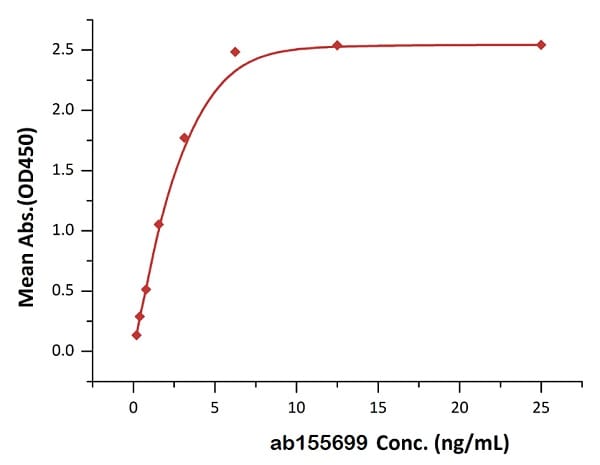Recombinant human TNF alpha protein (Active) (ab155699)
Key features and details
- Expression system: HEK 293 cells
- Purity: > 95% SDS-PAGE
- Endotoxin level: < 0.100 Eu/µg
- Active: Yes
- Suitable for: Functional Studies, SDS-PAGE, ELISA
Achieve higher consistency and quality standards with a premium grade bioactive protein
- High batch-to-batch consistency
- Optimal bioactivity
- Guaranteed identical to human native proteins
- >95% purity
- Ultra-low endotoxin levels: <0.005 Eu/µg
- Carrier and tag free
Description
-
Product name
Recombinant human TNF alpha protein (Active)
See all TNF alpha proteins and peptides -
Biological activity
Bioactivity is measured by its binding ability in a functional ELISA.
Immobilized ab155699 at 2 μg/mL ( 100 μl/well ) can bind Humira with a linear range of 0.2-2 ng/mL.
-
Purity
> 95 % SDS-PAGE.
>95% SEC-MALS. Purified by ion exchange chromatography. -
Endotoxin level
< 0.100 Eu/µg -
Expression system
HEK 293 cells -
Accession
-
Protein length
Full length protein -
Animal free
No -
Nature
Recombinant -
-
Species
Human -
Sequence
VRSSSRTPSDKPVAHVVANPQAEGQLQWLNRRANALLANGVELRDNQLVV PSEGLYLIYSQVLFKGQGCPSTHVLLTHTISRIAVSYQTKVNLLSAIKSP CQRETPEGAEAKPWYEPIYLGGVFQLEKGDRLSAEINRPDYLDFAESGQV YFGIIAL -
Predicted molecular weight
17 kDa -
Amino acids
77 to 233
-
Associated products
-
Related Products
Specifications
Our Abpromise guarantee covers the use of ab155699 in the following tested applications.
The application notes include recommended starting dilutions; optimal dilutions/concentrations should be determined by the end user.
-
Applications
Functional Studies
SDS-PAGE
ELISA
-
Form
Lyophilized -
Additional notes
Endotoxin levels determined by the LAL method.
-
 Concentration information loading...
Concentration information loading...
Preparation and Storage
-
Stability and Storage
Shipped at 4°C. Store at 4°C (stable for up to 12 months). Upon delivery aliquot. Store at -20°C or -80°C. Avoid freeze / thaw cycle. For long term storage it is recommended to add a carrier protein on reconstitution (0.1% HSA or BSA).
pH: 7.40
Constituents: PBS, 5% Trehalose
Lyophilized from 0.22 µm filtered solution.This product is an active protein and may elicit a biological response in vivo, handle with caution.
-
ReconstitutionReconstitute with sterile deionized water to a concentration of 200 µg/ml.
General Info
-
Alternative names
- APC1
- APC1 protein
- Cachectin
see all -
Function
Cytokine that binds to TNFRSF1A/TNFR1 and TNFRSF1B/TNFBR. It is mainly secreted by macrophages and can induce cell death of certain tumor cell lines. It is potent pyrogen causing fever by direct action or by stimulation of interleukin-1 secretion and is implicated in the induction of cachexia, Under certain conditions it can stimulate cell proliferation and induce cell differentiation. -
Involvement in disease
Genetic variations in TNF are a cause of susceptibility psoriatic arthritis (PSORAS) [MIM:607507]. PSORAS is an inflammatory, seronegative arthritis associated with psoriasis. It is a heterogeneous disorder ranging from a mild, non-destructive disease to a severe, progressive, erosive arthropathy. Five types of psoriatic arthritis have been defined: asymmetrical oligoarthritis characterized by primary involvement of the small joints of the fingers or toes; asymmetrical arthritis which involves the joints of the extremities; symmetrical polyarthritis characterized by a rheumatoidlike pattern that can involve hands, wrists, ankles, and feet; arthritis mutilans, which is a rare but deforming and destructive condition; arthritis of the sacroiliac joints and spine (psoriatic spondylitis). -
Sequence similarities
Belongs to the tumor necrosis factor family. -
Post-translational
modificationsThe soluble form derives from the membrane form by proteolytic processing.
The membrane form, but not the soluble form, is phosphorylated on serine residues. Dephosphorylation of the membrane form occurs by binding to soluble TNFRSF1A/TNFR1.
O-glycosylated; glycans contain galactose, N-acetylgalactosamine and N-acetylneuraminic acid. -
Cellular localization
Secreted and Cell membrane. - Information by UniProt
Images
-
ab155699 induces cytotoxicity effect on the WEH1-13VAR cells in the presence of the metabolic inhibitor actinomycin D.
The EC50 for this effect is 0.007-0.014 ng/ml (Routinely tested).
-
Neutralization assay shows that the cytotoxicity effect of ab155699 was inhibited by increasing concentration of Adalimumab.
The concentration of ab155699 used is 1 ng/mL.
The IC50 is 29 ng/mL (Routinely tested).
-
Immobilized ab155699 at 2 μg/mL (100 μL/well) binds Humira.
Linear range: 0.2-2 ng/mL (QC tested).
-
Immobilized ab155699 at 2 μg/mL (100 μL/well) binds ab174046.
Linear range: 0.2-3 ng/mL (Routinely tested).
-
Humira (Adalimumab) captured on CM5 chip via anti-human IgG Fc antibodies surface, can bindab155699 with an affinity constant of 0.255 nM, as determined in a SPR assay (Biacore T200) (Routinely tested).
-
Reduced ab155699 on SDS-PAGE, stained overnight with Coomassie Blue.
Purity of protein >95%
The protein migrates as 17 kDa and 18 kDa under reducing conditions.
-
Purity of ab155699 was more than 95% in HP-SEC, and around 47-60 kDa verified by SEC-MALS.
Protocols
To our knowledge, customised protocols are not required for this product. Please try the standard protocols listed below and let us know how you get on.
Datasheets and documents
-
Datasheet download
References (3)
ab155699 has been referenced in 3 publications.
- Pedersen ME et al. Assessment of immunogenicity and drug activity in patient sera by flow-induced dispersion analysis. Sci Rep 12:4670 (2022). PubMed: 35304547
- Pedersen ME et al. Size-based characterization of adalimumab and TNF-a interactions using flow induced dispersion analysis: assessment of avidity-stabilized multiple bound species. Sci Rep 11:4754 (2021). PubMed: 33637878
- Chen J et al. Early detection of Alzheimer's disease by peptides from phage display screening. Brain Res 1721:146306 (2019). PubMed: 31247207













